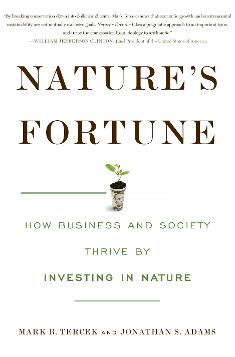Though this book has two named authors, Mark Tercek's voice is the one readers hear in its pages. A prefatory note explains that science writer Jonathan Adams worked on the writing and research with Tercek as a “strong and full partner” (ix). But for all practical purposes, Tercek is the author. He currently serves as the president and CEO of The Nature Conservancy, one of the most respected and well-funded nonprofit environmental organizations in the US, with a reputation for taking a scientific approach to identifying land that should be preserved and buying it or establishing a partnership with its owners, whether public or private, to conserve its natural resources. Before he joined TNC, Tercek was a managing director and partner at Goldman Sachs, the successful and powerful investment bank.
Tercek’s business background becomes key to the core purpose of the book: He wants “business, government, and individuals to understand that nature is not only wonderful, it is also economically valuable” because it provides the “fundamental underpinning to human well-being” (xviii). Lots of folks know this on a general, cosmic level, but he wants readers to act on it on a practical level. As support for this claim, he discusses the dependence of business on natural capital (like a forest upstream of a river that supplies water to cities and manufacturing plants) and green infrastructure consisting of “woodlands and grasslands, wetlands and rivers” and contrasting with built infrastructures of sewer systems, highways, bridges, power grids, and buildings (23). The chapters provide stories about how multi-national corporations like Coca-Cola, Cargill, McDonald’s, and Dow have learned that facilities and production processes that protect natural resources and species biodiversity make business sense. Often they save money in the short run, but they also preserve access to the clean water, fishing grounds, healthy pastures, and productive fields that are essential to all of us as well as to business. Similarly, active, on-going collaboration between stakeholders (governments at the state, local, and national levels; local residents; consumers; environmentalists; and businesses) can lead to better solutions to the old problems of pollution and resource exhaustion as well as the new problem of climate change with its more frequent extreme weather events. “Sustainability and profitability go together,” he reasons (175).
The book’s target audiences certainly include business and government decision makers, but also environmentalists who are perennially suspicious of corporate greenwashing, as when companies make a show of being environmentally friendly without significantly changing their operations. Tercek draws a compelling analogy between keystone species in an ecosystem and large corporations that control vast areas—logging companies’ forests and agricultural companies’ fields, for example (165-67). He suggests that working with these large, powerful companies is better policy than ignoring them or antagonizing them. Despite environmentalists’ reservations about industry, industry meets the demands of basic human needs for food, energy, space, and water. Companies will not vanish to enable preservation of threatened ecosystems and species. If they did, open, undeveloped areas may face new threats from commercial and residential development. So he challenges all stakeholders to apply science, technology, and historical and cultural knowledge to finding solutions that work for everyone.
Perhaps the most provocative example of re-imagining the basic equation between business and nature comes in the example of Interface, the world’s largest carpet tile manufacturer, and its late CEO, Ray Anderson. Anderson was converted from being a self-described plunderer of natural resources to a hopeful business revolutionary. Instead of producing a product by using up natural resources and creating landfill waste, he set a goal of “zero waste, zero impact, and zero footprint by 2020” (173). In essence, his carpet company has come to view itself as providing a service (nice floors), rather than a product (carpet), via a closed loop manufacturing process where all waste is used and reused. This shift in thinking may help our society find a way to curb the unsustainable consumption of natural resources that is the huge downside of materialism and capitalism.
An easy, quick read, the book seems crafted for the business community more than for leisure, literary, or scientific readers. It includes a smattering of anecdotes about intriguing individuals and tales of companies that have acted sustainably. It offers examples of how business people and environmentalists can collaborate and, indeed, have collaborated. These persuasively support Tercek’s conclusion:
A new valuation, one that integrates conservation values and human development, science and economics means seeing things whole; if we want a successful business, a livable city, a green, diverse and vibrant planet, we have to take nature into account and recognize the real value of the service nature provides. (197-98)
Yes, it’s prose, not poetry. But maybe that’s the voice that will resonate in boardrooms, which would be plenty.
* * *
Elizabeth Giddens is professor of English at Kennesaw State University in Georgia. She received her Ph.D. from the University of Tennessee, Knoxville, in English with a specialty in rhetoric and composition. Recent publications include “Encountering Social-Constructivist Rhetoric: Teaching John McPhee’s Classic in an Environmental Writing and Literature Course” in Teaching Ecocriticism and Green Cultural Studies (Palgrave McMillan, 2011), “Saving the Next Tree: The Georgia Hemlock Project, Community Action, and Environmental Literacy” in Community Literacy Journal (Fall 2009), and “’Something Unusual in Hotel Accommodations’: Visiting the Smokies Early in the Twentieth Century,” in Smokies Life (Fall 2010).
